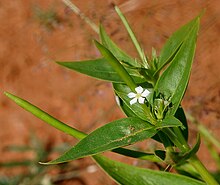Catharanth
| Catharanth | ||||||||||||
|---|---|---|---|---|---|---|---|---|---|---|---|---|

Pink Catharanthe ( Catharanthus roseus ) |
||||||||||||
| Systematics | ||||||||||||
|
||||||||||||
| Scientific name | ||||||||||||
| Catharanthus | ||||||||||||
| G.Don |
The Catharanthen ( Catharanthus ), also called room evergreen , are a genus of plants from the subfamily of the Rauvolfioideae in the family of the dog poison plants (Apocynaceae).
description
Catharanth are annual or perennial, evergreen herbaceous plants that often lignify at the base and branch out to varying degrees. The stems are fleshy. The entire, herbaceous to slightly leathery and fringed or occupied with Drüsenzotten leaves are opposite and provided with a short and fixed peak.
The terminal (although they seem to grow laterally) inflorescences have one or two radial symmetry , five-fold flowers . The sepals are narrow to very narrow, elongated, awl-shaped and without glandular hairs. The five purple, red, pink or white petals are fused into a tube and their corolla lobes are spread out flat. The corolla tube is hairy, the throat is narrowed and woolly hairy. The five corolla lobes are obliquely inverted-egg-shaped and finely covered with needle-shaped outgrowths. The stamens start at the widest point of the corolla tube, which is usually above the middle, the anthers are oblong at the base. The ovary is composed of two very narrow, elongated carpels . The disc consists of two narrowly triangular to narrowly elongated glands, the bases of which touch each other on the side of the carpels facing away from the axis. The stylus is thread-shaped. The fruit is a two-seeded pelvic fruit , the fruit body is cylindrical and tapering to a point. The seeds are black and elongated, the surface wrinkled.
distribution
Except for one species, Catharanthus pusillues , which is found in India and Sri Lanka , all species are endemic to Madagascar .
Systematics
The genus was first described in 1837 by George Don Jr. The generic name means something like "pure blood" and refers to the rose-colored flowers. The species of the genus were temporarily placed under the genera Vinca and Lochnera . According to the system of Endress & Bruyns (2000), Catharanthus belongs to the tribe Vinceae, together with genera such as periwinkle ( Vinca ) and Kopsia .
A work by Sennblad & Bremer 2002 presented the Vinceae as monophyletic. The following cladogram shows the relationships between Catharanthus according to this source. The association of the four genera shown here is well established.
| Ochrosia | |||||||||||||||||||||
| Rauvolfia | |||||||||||||||||||||
| Vinca | |||||||||||||||||||||
| Catharanthus | |||||||||||||||||||||
The genus contains about nine species:
- Catharanthus coriaceus Markgr. : It occurs in central Madagascar.
- Catharanthus lanceus (Bojer ex A.DC.) Pichon : It occurs in central Madagascar.
- Catharanthus longifolius (Pichon) Pichon : It occurs in south-central and southern Madagascar.
- Catharanthus makayensis L. Allorge, Phillipson & Razakamal. : This species from Madagascar was first described in 2015.
- Catharanthus ovalis Markgr. : It occurs in south-central Madagascar.
- Catharanthus pusillus (Murray) G.Don : It occurs in India, Sri Lanka, Nepal and the western Himalayas.
- Pink-colored Catharanthe ( Catharanthus roseus Markgr. ), Is the best known species, it is used as an ornamental and medicinal plant. It was originally found in eastern and southern Madagascar. There are two varieties.
- Catharanthus scitulus (Pichon) Pichon : It occurs in southern and southeastern Madagascar.
- Catharanthus trichophyllus (Baker) Pichon : It occurs in north-western, northern and eastern Madagascar.
literature
- AJM Leeuwenberg, FK Kupicha et al .: Apocynaceae. In: Flora Zambesiaca. Volume 7, Part 2, 1985, ( online )
Web links
Individual evidence
Most of the information in this article has been taken from the sources given under references; the following sources are also cited:
- ↑ a b c d Gordon Cheers (Ed.): Botanica , p. 199, 2003, ISBN 3-8331-1600-5
- ↑ Helmut Genaust: Etymological dictionary of botanical plant names. 3rd, completely revised and expanded edition. Birkhäuser, Basel / Boston / Berlin 1996, ISBN 3-7643-2390-6 (reprint ISBN 3-937872-16-7 ).
- ^ ME Endress, PV Bruyns: A revised classification of the Apocynaceae sl Bot. Rev. 66, 2000, pp. 1-56.
- ↑ B. Sennblad, B. Bremer: Classification of Apocynaceae sl according to a new approach combining Linnaean and phylogenetic taxonomy . Syst. Biol. 51 (3), 2002, pp. 389-409. (PDF)
- ↑ a b c d e f g h i j k Rafaël Govaerts (ed.): Catharanthus - World Checklist of Selected Plant Families des Royal Botanic Gardens, Kew. Last accessed on November 18, 2018.

